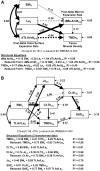Phenotypic integration of skeletal traits during growth buffers genetic variants affecting the slenderness of femora in inbred mouse strains
- PMID: 19082857
- PMCID: PMC2650248
- DOI: 10.1007/s00335-008-9158-1
Phenotypic integration of skeletal traits during growth buffers genetic variants affecting the slenderness of femora in inbred mouse strains
Abstract
Compensatory interactions among adult skeletal traits are critical for establishing strength but complicate the search for fracture susceptibility genes by allowing many genetic variants to exist in a population without loss of function. A better understanding of how these interactions arise during growth will provide new insight into genotype-phenotype relationships and the biological controls that establish skeletal strength. We tested the hypothesis that genetic variants affecting growth in width relative to growth in length (slenderness) are coordinated with movement of the inner bone surface and matrix mineralization to match stiffness with weight-bearing loads during postnatal growth. Midshaft femoral morphology and tissue-mineral density were quantified at ages of 1 day and at 4, 8, and 16 weeks for a panel of 20 female AXB/BXA recombinant inbred mouse strains. Path Analyses revealed significant compensatory interactions among outer-surface expansion rate, inner-surface expansion rate, and tissue-mineral density during postnatal growth, indicating that genetic variants affecting bone slenderness were buffered mechanically by the precise regulation of bone surface movements and matrix mineralization. Importantly, the covariation between morphology and mineralization resulted from a heritable constraint limiting the amount of tissue that could be used to construct a functional femur. The functional interactions during growth explained 56-99% of the variability in adult traits and mechanical properties. These functional interactions provide quantitative expectations of how genetic or environmental variants affecting one trait should be compensated by changes in other traits. Variants that impair this process or that cannot be fully compensated are expected to alter skeletal growth leading to underdesigned (weak) or overdesigned (bulky) structures.
Figures







Similar articles
-
Genetic variation in bone growth patterns defines adult mouse bone fragility.J Bone Miner Res. 2005 Nov;20(11):1983-91. doi: 10.1359/JBMR.050707. Epub 2005 Jul 11. J Bone Miner Res. 2005. PMID: 16234972
-
Genetic randomization reveals functional relationships among morphologic and tissue-quality traits that contribute to bone strength and fragility.Mamm Genome. 2007 Jul;18(6-7):492-507. doi: 10.1007/s00335-007-9017-5. Epub 2007 Jun 8. Mamm Genome. 2007. PMID: 17557179 Free PMC article.
-
Phenotypic integration among trabecular and cortical bone traits establishes mechanical functionality of inbred mouse vertebrae.J Bone Miner Res. 2009 Apr;24(4):606-20. doi: 10.1359/jbmr.081224. J Bone Miner Res. 2009. PMID: 19063678 Free PMC article.
-
Systems analysis of bone.Wiley Interdiscip Rev Syst Biol Med. 2009 Jul-Aug;1(1):73-88. doi: 10.1002/wsbm.15. Wiley Interdiscip Rev Syst Biol Med. 2009. PMID: 20046860 Free PMC article. Review.
-
Dissecting the Genetics of Osteoporosis using Systems Approaches.Trends Genet. 2019 Jan;35(1):55-67. doi: 10.1016/j.tig.2018.10.004. Epub 2018 Nov 20. Trends Genet. 2019. PMID: 30470485 Free PMC article. Review.
Cited by
-
Establishing biomechanical mechanisms in mouse models: practical guidelines for systematically evaluating phenotypic changes in the diaphyses of long bones.J Bone Miner Res. 2015 Jun;30(6):951-66. doi: 10.1002/jbmr.2539. J Bone Miner Res. 2015. PMID: 25917136 Free PMC article. Review.
-
HBM Mice Have Altered Bone Matrix Composition and Improved Material Toughness.Calcif Tissue Int. 2016 Oct;99(4):384-95. doi: 10.1007/s00223-016-0154-2. Epub 2016 May 26. Calcif Tissue Int. 2016. PMID: 27230741 Free PMC article.
-
Components of the Gut Microbiome That Influence Bone Tissue-Level Strength.J Bone Miner Res. 2021 Sep;36(9):1823-1834. doi: 10.1002/jbmr.4341. Epub 2021 Jun 4. J Bone Miner Res. 2021. PMID: 33999456 Free PMC article.
-
External Bone Size Is a Key Determinant of Strength-Decline Trajectories of Aging Male Radii.J Bone Miner Res. 2019 May;34(5):825-837. doi: 10.1002/jbmr.3661. Epub 2019 Feb 4. J Bone Miner Res. 2019. PMID: 30715752 Free PMC article.
-
Serum IGF-1 affects skeletal acquisition in a temporal and compartment-specific manner.PLoS One. 2011 Mar 18;6(3):e14762. doi: 10.1371/journal.pone.0014762. PLoS One. 2011. PMID: 21445249 Free PMC article.
References
-
- Akhter MP, Wells DJ, Short SJ, Cullen DM, Johnson ML, et al. Bone biomechanical properties in LRP5 mutant mice. Bone. 2004;35:162–169. - PubMed
-
- Bailey DW. Genes that affect morphogenesis of the murine mandible. Recombinant-inbred strain analysis. J Hered. 1986;77:17–25. - PubMed
-
- Belknap JK. Effect of within-strain sample size on QTL detection and mapping using recombinant inbred mouse strains. Behav Genet. 1998;28:29–38. - PubMed
-
- Brear K, Currey JD, Pond CM. Ontogenetic changes in the mechanical properties of the femur of the polar bear Ursus maritimus. J Zool Lond. 1990;222:49–58.
-
- Carrier D, Leon LR. Skeletal growth and function in the California gull (Larus californicus) J Zool Lond. 1990;222:375–389.
Publication types
MeSH terms
Grants and funding
LinkOut - more resources
Full Text Sources
Molecular Biology Databases

